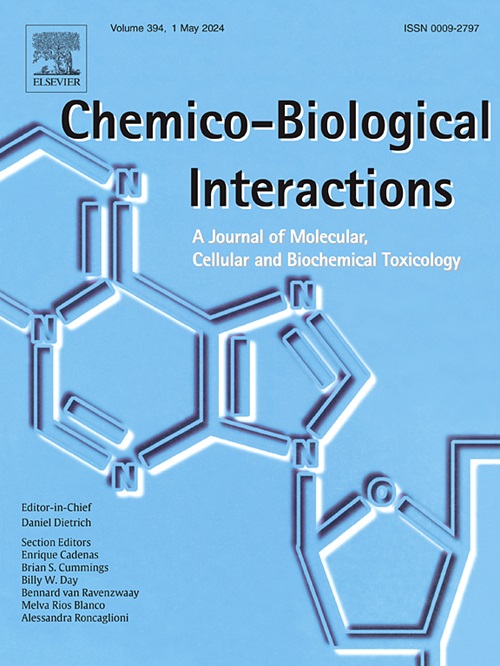Inhibition of bromodomain and extra-terminal (BET) proteins with JQ1 exacerbates acetaminophen-induced hepatotoxicity by altering detoxification pathways and oxidative stress responses
IF 4.7
2区 医学
Q1 BIOCHEMISTRY & MOLECULAR BIOLOGY
引用次数: 0
Abstract
Acetaminophen (APAP) is a widely used over-the-counter drug for the treatment of fever and pain. At therapeutic doses, APAP has a relatively safe profile. However, at supratherapeutic doses it can produce liver injury and even fatal hepatotoxicity. Antioxidant genes regulated by the Kelch-like ECH-associated protein 1 (KEAP1)-nuclear factor, erythroid 2-like 2 (NRF2) pathway play a crucial role in hepatoprotection against APAP-induced hepatotoxicity and oxidative stress. Recent studies suggest that bromodomain and extra-terminal motif (BET) proteins, epigenetic readers, act as putative regulators of the KEAP1-NRF2 pathway, but their role in acute drug-induced liver injury (DILI) remains unclear. In this study, we employed complementary in vitro and in vivo approaches utilizing pharmacological inhibition and gene knockdown techniques to examine the role of BET proteins in APAP-induced toxicity. Our findings indicate that APAP treatment significantly alters the gene and protein expression of BET proteins in both mouse liver and the HC-04 cell line. Cytotoxicity analysis using lactate dehydrogenase (LDH) leakage assay revealed that treatment with the small molecule BET inhibitor JQ1 did not alter APAP-induced cytotoxicity. However, siRNA-mediated knockdown of the BET genes Brd3 and Brd4, but not Brd2, reduced APAP-induced cytotoxicity in HC-04 cells. In hepatic gene expression analysis experiments, JQ1 pretreatment in mice activated the Nrf2 pathway and altered antioxidant genes such as Gclc, Gclm, Ho-1, and Txnrd1, suggesting an enhancement of cellular defenses against APAP-induced oxidative stress at 12 h timepoint. However, by 24 h, histopathological findings revealed significant liver necrosis and inflammation in the JQ1-APAP treated group, indicating that while BET inhibition may confer early protection, it may not fully prevent long-term liver injury.
JQ1抑制溴域和外端(BET)蛋白通过改变解毒途径和氧化应激反应加剧对乙酰氨基酚诱导的肝毒性。
对乙酰氨基酚(APAP)是一种广泛使用的非处方药,用于治疗发烧和疼痛。在治疗剂量下,APAP具有相对安全的特性。然而,在超治疗剂量下,它可以产生肝损伤甚至致命的肝毒性。Kelch-like ECH-associated protein 1 (KEAP1)-nuclear factor, erythroid 2-like 2 (NRF2) pathway调控的抗氧化基因在抗apap诱导的肝毒性和氧化应激的肝保护中发挥重要作用。最近的研究表明,溴域和外端基序(BET)蛋白作为表观遗传解读器,可能是KEAP1-NRF2通路的调节因子,但它们在急性药物性肝损伤(DILI)中的作用尚不清楚。在这项研究中,我们采用了互补的体外和体内方法,利用药理抑制和基因敲低技术来研究BET蛋白在apap诱导的毒性中的作用。我们的研究结果表明,APAP处理显著改变了小鼠肝脏和HC-04细胞系中BET蛋白的基因和蛋白表达。使用乳酸脱氢酶(LDH)泄漏试验进行的细胞毒性分析显示,使用小分子BET抑制剂JQ1处理并没有改变apap诱导的细胞毒性。然而,sirna介导的敲低BET基因Brd3和Brd4,而不是Brd2,降低了apap诱导的HC-04细胞的细胞毒性。在肝脏基因表达分析实验中,JQ1预处理小鼠激活Nrf2通路,改变抗氧化基因如Gclc、Gclm、Ho-1和Txnrd1,提示在12 h时间点增强细胞对apap诱导的氧化应激的防御能力。然而,在24小时内,组织病理学结果显示JQ1-APAP治疗组明显的肝坏死和炎症,这表明尽管BET抑制可能提供早期保护,但它可能不能完全预防长期肝损伤。
本文章由计算机程序翻译,如有差异,请以英文原文为准。
求助全文
约1分钟内获得全文
求助全文
来源期刊
CiteScore
7.70
自引率
3.90%
发文量
410
审稿时长
36 days
期刊介绍:
Chemico-Biological Interactions publishes research reports and review articles that examine the molecular, cellular, and/or biochemical basis of toxicologically relevant outcomes. Special emphasis is placed on toxicological mechanisms associated with interactions between chemicals and biological systems. Outcomes may include all traditional endpoints caused by synthetic or naturally occurring chemicals, both in vivo and in vitro. Endpoints of interest include, but are not limited to carcinogenesis, mutagenesis, respiratory toxicology, neurotoxicology, reproductive and developmental toxicology, and immunotoxicology.

 求助内容:
求助内容: 应助结果提醒方式:
应助结果提醒方式:


